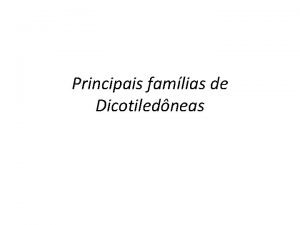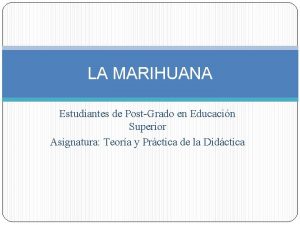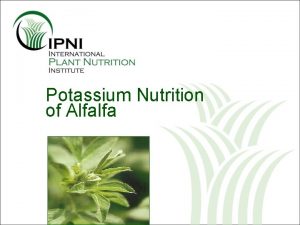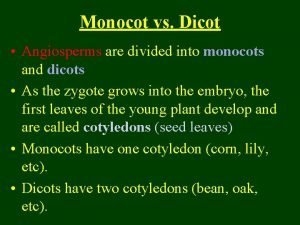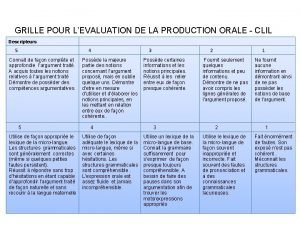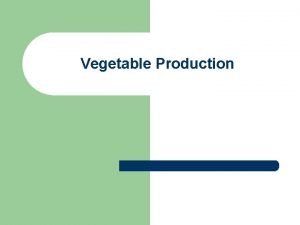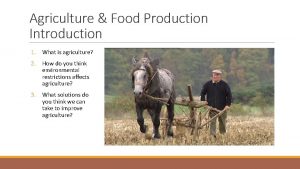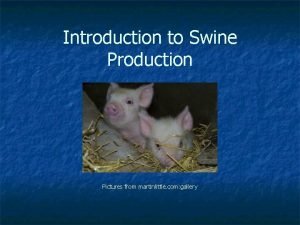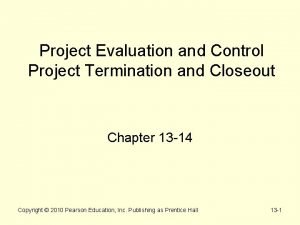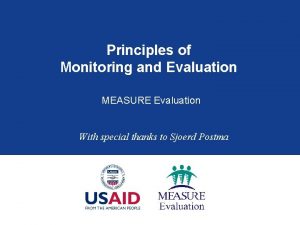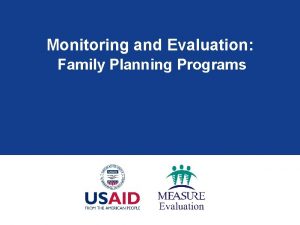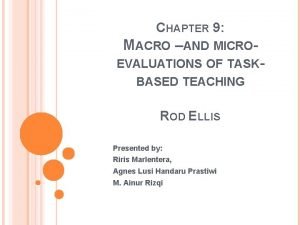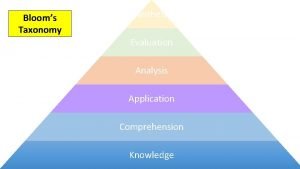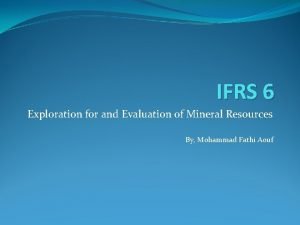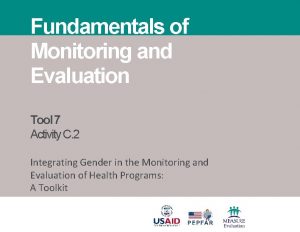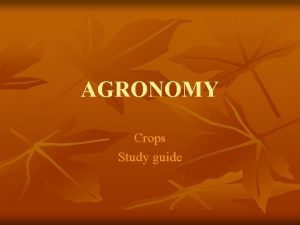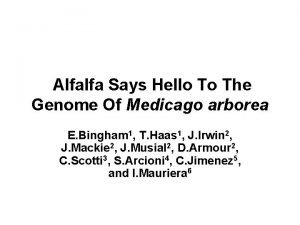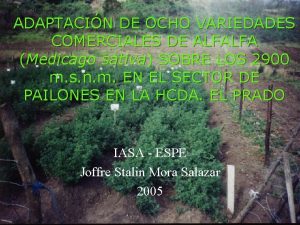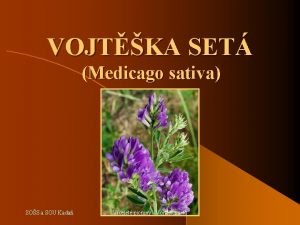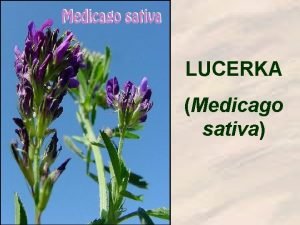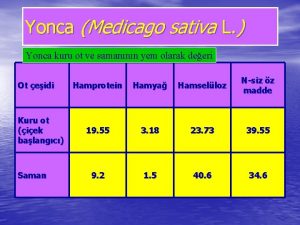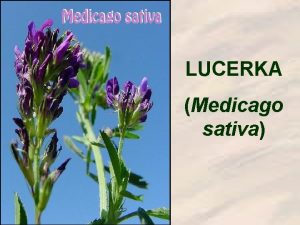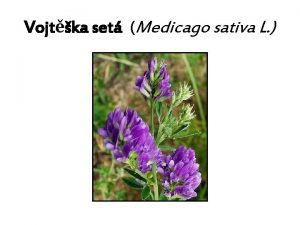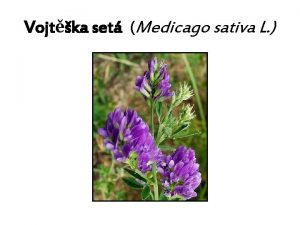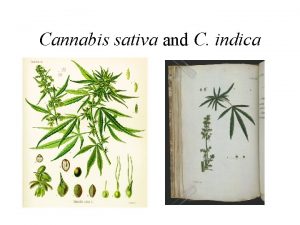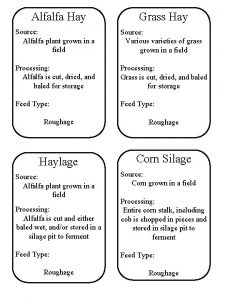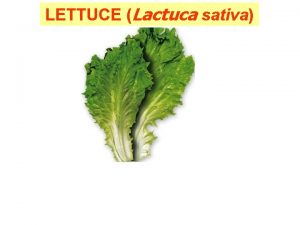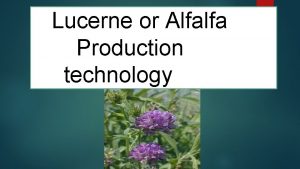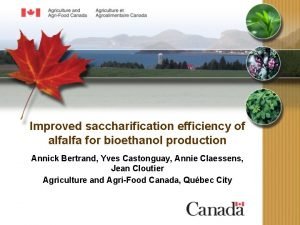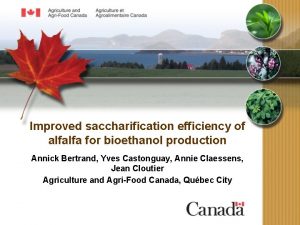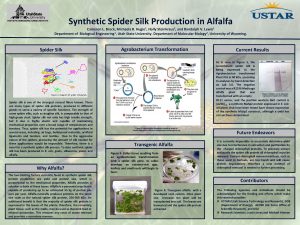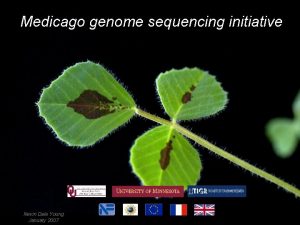Alfalfa Production Introduction and Evaluation Introduction Medicago sativa



















































- Slides: 51

Alfalfa Production Introduction and Evaluation

Introduction Medicago sativa Introduced into US 1736 Oldest cultivated forage crop Rich in protein, vitamins, and minerals Very high yield Remains of alfalfa more than 6000 years old were found in Iran Today alfalfa is coast to coast on 23. 6 million acres. Average yield of 3. 35 tons/acre

Benefits Beneficial insects Attracts wildlife Nitrogen fixation Alfalfa replaces high Nrequiring crops Alfalfa provides N to a subsequent crop Improves Soil Tilth Protect groundwater

Leading States – Acres Planted Montana South Dakota North Dakota Idaho Minnesota Wisconsin Nebraska California Kansas Colorado

Leading Stated - Yeilds Arizona California Texas Washington Oregon New Mexico Idaho, Nevada Kansas Indiana, Iowa, Utah 8. 6 7. 0 5. 3 5. 2 4. 7 4. 6 4. 4 4. 3 4. 2

Production (in 1000 tons) California Idaho Montana Minnesota, South Dakota Wisconsin Nebraska Kansas Arizona Colorado, North Dakota 5, 040 4, 400 3, 600 3, 400 3, 200 3, 113 3, 010 2, 408 2, 380

Basics Among US field crops, alflalfa is 3 rd. Behind corn & soybeans. In California, alfalfa is 1 st. Followed by rice & cotton Grown for seed, meal, cover, mostly for hay Alfalfa lives from 5 to 7 years

Where is California is Alfalfa grown?

Top Producing Counties Imperial Kern Merced Tulare Riverside 18. 3% 11. 3% 9. 4% 8. 4%

Consumers Dairy = 60% Meat Animals = 25% Horses = 15%

Plant Biology Alfalfa is a legume Grow about 3 ft. high & compound leaves Stems grow from buds on crown (base) Racemes. Alfalfa roots 25 -30 feet or more under favorable conditions

Types of Alfalfa Hardy northern part of the US and in Canada. Medium hardy are raised mainly in the central United States. Nonhardy thrive on irrigated land in the Western United States

Growing Alfalfa Flourish in fertile, well -drained soil that is neutral or slightly alkaline Plant in early spring or late summer Cut after the plants begin to produce flower buds, but before the seed pods form.

Dormancy

Dormancy

Fall dormancy and winter hardiness of Alfalfa products

Variety Selection Factors Yield Potential -5% improvement in yield Stand Persistence<5 plants/square ft. Hardiness & Dormancy Disease and Insect Resistance

Visual evaluation Stage of maturity-maturity at harvest influences quality more than any other factor. Leafiness-contain highly digestible energy and at least two-thirds of the protein found in hay. Color-bright green is a good indicator of proper curing, good palatability. Foreign material-weeds and straw have little or no feeding value Odor and condition

Designations - Grades Supreme: very early maturity; prebloom; soft, fine -stemmed, extra leafy (factors indicative of very high nutritive content, TDN 56% and higher); excellent in color and free of damage – This grade was developed in 1998. Excellent (Premium)-Prebloom stage low fiber, high energy/protein TDN (54% and higher) Good-Early bloom stage, low to medium fiber, high protein and energy TDN (52 -54 %) Fair-Mid-late bloom coarse texture TDN (49 -52%) Poor- full to late bloom very coarse very little leaf TDN (<49%)

Hay Grading in California Lot - A lot is hay from the same field, same cutting, and having the same stage of maturity. A lot can be of any size. Sampling site - The sample is taken from the ends of 20 bales (horizontally) with a core sampler. Sampling is done by the party seeking the information on hay quality. Analyses - The hay is analyzed for moisture concentration or dry matter (DM), and modified crude fiber (MCF), assumed to be fiber plus silica (soil). The analyses are performed by commercial laboratories, who supply the results to the party who developed the sample.

Hay Grading in California Estimated values - Estimated values include total digestible nutrients (TDN), estimated net energy (ENE), and digestible protein (DP) based on modified crude fiber. Hay grades - Hay grades are based on estimated net energy and are classified as excellent, good, fair, or poor. Visual appraisal - This appraisal, performed by either the buyer or the seller, is based on stage of maturity, leafiness, foreign matter, color, and conditions at harvest. California producers also have proposed a method of evaluating hay prices in terms of estimated quality.

Laboratory analyses Dry matter (DM) Crude protein (CP) Acid detergent fiber (ADF) Total digestible nutrients (TDN) Relative feed value (RFV) Net Energy for Lactation (NEL)

Laboratory analyses Moisture Crude Protein Fiber TDN NEL Moisture 9. 25 0% 0% 0% Crude Protein 23. 88 10% 10% 10% Fiber Act. % TDN 20. 36 59. 46 NEL 1. 35

Laboratory analyses Quality Designations: Relative Feed Value RFV Supreme Over 180 Premium 150 -180 Good 125 -150 Fair 100 -125 Acid Detergent Fiber Crude Protein ADF CP Under 27. 22 or over 27 -29. 20 -. 22 29 -32. 18 -. 20 32 -35. 15 -. 18

Alfalfa Perennial Deep rooted Needs good soil & Good Drainage Dormant, Semi Dormant, Non-Dormant

Alfalfa Deep loam 8’ – 40’ Ph – 6. 5 – 7. 5 Level fields – irrigation slope. 2’ -. 4’/100’

Seedbed Laser level Borders 100’ – 200’ wide (Border Machine) Pre-plant fertilizer = 6 -20 -20, 9 -19 -0, 1146 -0 Pre-plant Herbicide = incorporated – eptan, balan. Established – Karmex, treflan

Seedbed Preparation Heavy work n n Disc 2 x’s with stubble disk Sub soil Finish work n n Landplane 2 x’s Put up borders

Plant September and sprinkled up Brillion seeder 25 -30 lbs. /ac 15 lbs. /ac = 64 plants/sq. ft. 25 lbs. /ac = 107 plants/sq. ft. 35 lbs. /ac = 150 plants/sq. ft. 45 lbs. /ac = 193 plants/sq. ft.

Plant Time n Fall or Spring Method n n Broadcast Drill Depth n Lightly cover

Irrigation Problems = Too Soon Too Much Too Little Too Late Alfalfa will extract: 46% of its water from the top 2’ 26% of its water from the top 2’-4’ 18% of its water from the top 4’-6’ 10% of its water from the top 6’-8’

Irrigation Total for season n 4’-5’ Timing n n 1 st. Irrigation critical 1 st. Choice is no irrigation before 1 st. Cutting Number of irrigations n Depends on the number of cutting and weather conditions Source of water n Ditch water or well water

Irrigation Loss – wind, temperature, radiation, Humidity ET – Evapotranspiration Rate KMJ

Pests – Egyptian Alfalfa Weevil 1. Alfalfa caterpillar 2. Army worm (yellow butterfly) 3. Aphids 4. Alfalfa Weevil (Hypera postica) 5. Egyptian Alfalfa Weevil( Hypera Brunneipennis) Different Species but almost identical in most respects.

Alfalfa Caterpillar

Army worm

Aphids

Weevils

A. Thrive in cool spring weather B. Adults lay eggs in the stem C. When the eggs hatch, the larvae emerge and begin feeding on the leaves. D. So. Calif. & Arizona - Feb to April E. No. Calif. – March to May F. Weevils generally affect 1 -2 cuttings G. Parasitic wasp (Bathyplectes curulionis) H. Furadan – Permit & gets bees I. Lorsban – non permit & doesn’t bother bees.

Diseases A. Phytophthora – moisture related B. Nematodes – Sandy Soils C. Leafspot – spotted leaves D. Anthracnose – Leaf E. Rhizoctonia - @ crown; moisture related. F. Fusarium – Wilt

Phytophthora

Leaf spot

Anthracnose

Rhizoctonia

Fusarium

Weed control in established stand Main weeds n n Fiddle neck, chickweed, foxtail, groundsel, Malva, curly dock, ect. . Control n Depends on the time of year and type of weed.

Fertilization of established stand Spring n n 250 lbs. /ac ammonium phosphate 11 -52 -0 Lime

Harvesting 21 -35 Days (depends on the farmer) Re-growth of shoot and maturity. Swather – windrows Rake – 55% - 65% moisture Bale 17% - 20% Big Bale 10%– 11% Cured – 10% - 12%

Harvesting Swather cost Curing time n Depends on weather Raking n n n Types 4 1/2 to 5 mph Lube every 50 – 75 hours Baling n n n Big bale Small bale Moisture

Custom Harvest Swath Rake Bale Roadside Green Chop

Yields Tons per acre n 6 to 8 tons per acre Number of cuttings n 6 to 8 (3 to 11) Cash cost per acre
 Legume roughages
Legume roughages Cannabis sativa ordem
Cannabis sativa ordem Sativa originaria de las cordilleras del himalaya
Sativa originaria de las cordilleras del himalaya Cabanis sativa
Cabanis sativa Todo alfalfa
Todo alfalfa Monocot eudicot
Monocot eudicot Contoh diagram alir proses produksi
Contoh diagram alir proses produksi Grille d'evaluation production orale
Grille d'evaluation production orale Introduction to monitoring and evaluation
Introduction to monitoring and evaluation Introduction of evaluation
Introduction of evaluation Introduction of evaluation
Introduction of evaluation Vegetable production introduction
Vegetable production introduction Food production introduction
Food production introduction Introduction to production management
Introduction to production management Introduction to production management
Introduction to production management Swine production introduction
Swine production introduction Progress and performance measurement and evaluation
Progress and performance measurement and evaluation Picme2.0
Picme2.0 Evaluation in progress
Evaluation in progress Inventory management and production planning and scheduling
Inventory management and production planning and scheduling Simon and chabris evaluation
Simon and chabris evaluation Pme project management
Pme project management Comparison between monitoring and evaluation
Comparison between monitoring and evaluation Project evaluation and control
Project evaluation and control Project evaluation and control
Project evaluation and control 7 principles of monitoring and evaluation
7 principles of monitoring and evaluation Monitoring and evaluation dashboard
Monitoring and evaluation dashboard Monitoring and evaluation of family planning programs
Monitoring and evaluation of family planning programs Concept map of measurement assessment and evaluation
Concept map of measurement assessment and evaluation Knowledge management monitoring and evaluation
Knowledge management monitoring and evaluation Eti isef
Eti isef Importance of planning, monitoring and evaluation
Importance of planning, monitoring and evaluation Implementing hrd programs
Implementing hrd programs Execution and evaluation
Execution and evaluation Prognostic test
Prognostic test M & e plan template
M & e plan template Macro and micro evaluation
Macro and micro evaluation Community health planning and implementation
Community health planning and implementation Knowledge comprehension
Knowledge comprehension What is transformational advertising
What is transformational advertising User interface design and evaluation
User interface design and evaluation Principles of monitoring and evaluation
Principles of monitoring and evaluation Free will and determinism evaluation
Free will and determinism evaluation Exploration and evaluation assets
Exploration and evaluation assets Measurement and evaluation in human performance 5e download
Measurement and evaluation in human performance 5e download What is hseep
What is hseep Basics of monitoring and evaluation
Basics of monitoring and evaluation Internal and external evaluation in education
Internal and external evaluation in education Evaluasi dan tindak lanjut program bk
Evaluasi dan tindak lanjut program bk Fedex balanced scorecard
Fedex balanced scorecard Chapter 6 implementation and evaluation
Chapter 6 implementation and evaluation Country evaluation and selection
Country evaluation and selection

